How To Create A Staff Scheduling Template
Could your business benefit from better employee scheduling? Learn how to create...

As a manager, your day is filled with countless repetitive tasks: checking and logging inventory, ordering supplies, tallying receipts, creating weekly schedules, calculating hours worked, writing job descriptions. The list literally goes on and on.
But did you ever stop to think about the process of doing all these activities? You certainly don’t start ordering supplies by recreating the order form every time. Chances are, you use some kind of document — saved on your computer or in a binder — to keep track of all this information. Chances are, you use a template.
Nowhere is this idea of a template more important than in the creation of your employee work schedule. Unfortunately, many managers neglect the use of a weekly schedule template. This makes their work life infinitely more difficult.
The experts at Sling are here to show you how a weekly schedule template can give you more time to deal with the pressing issues that you face on a daily basis. Along the way, we’ll address such questions as:
We’ll also show you how you can use your computer or mobile device to harness the power and versatility of Sling to streamline your scheduling activity even further. Before we do that, let’s answer the most basic question of all regarding the weekly schedule template: Why use one?

The weekly schedule template cuts down on the time you, the busy manager, spend getting things ready BEFORE you begin scheduling. You don’t have to remake the form you’re going to use because the template is already there and waiting.
All you have to do is open the blank form on your computer or retrieve an already-printed copy from your files. Then, just fill in the information, and you’re good to go.

One of the best things you can do to make your life — and the lives of your employees — easier is to keep your schedules simple. It’s not necessary to spend valuable time plugging in every single piece of information that’s pertinent to the job. And your employees don’t need to spend time trying to take in and decipher all that data.
A person should be able to look at the schedule and figure out within a few seconds what day she’s working, what hours she’ll be there, and the job she’ll be doing. If that’s not possible, your schedule may be too complicated.
Not sure if you’ve got too much information on the page? Practice on yourself. Look away from the screen or the printed schedule, choose an employee, then glance back at the schedule and figure out when you (the employee) are working.
If you have a stopwatch, time yourself. If it takes more than half a minute, you may need to make some changes to your scheduling process.

In line with the keep-it-simple rule above, here are the basics to include on your weekly schedule template. We’ve also added a few suggestions for making your schedule easy to read.
Your schedule needs:
If all employees are usually scheduled for one job (e.g., server or chef or hostess) and don’t switch very often, leave this last piece of information off your template so as not to clutter up the schedule.
That doesn’t mean that your host can’t grab an apron and cover for a server when the need arises. It simply means that you’re not scheduling employees for multiple jobs.
Other effective ways to keep your schedule simple include:
These are just a few basic suggestions for making your schedule as simple as possible while still conveying the necessary information.
The best way to get started using a weekly schedule template is to create one yourself. Microsoft Excel is the natural choice for the do-it-yourself template because of its flexibility. It can take a significant amount of time to get everything set up the way you want, but when you get it finalized, the scheduling process will be much easier.
The only way to make this process simpler is to use scheduling software, like Sling. We’ll show you the benefits of going that route in the next section. For now, let’s focus on setting up your own weekly schedule template in Excel.
Microsoft has already produced a good number of schedule templates for their suite of programs (e.g., Word, Excel, PowerPoint, etc.), like the one pictured below.
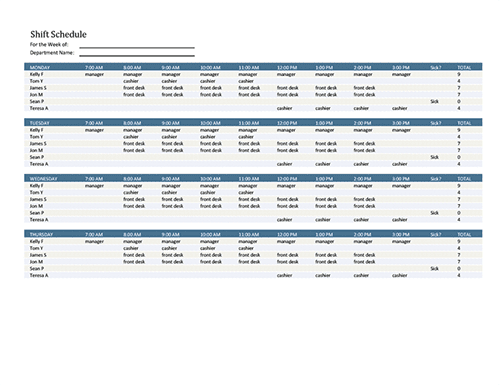
Source: Templates.Office.com
Here’s how to modify a ready-made template to fit your business.
If you don’t have access to Excel or you’d like an even simpler weekly schedule template, check out the last section of this article for details.
Put yourself in your employees’ shoes and read the weekly schedule template from their perspective. Is it easy to understand? What questions might your employees have about the final schedule?
Taking these things into consideration before using a weekly schedule template to produce your finished draft will prevent potential problems. Here are some other questions to consider before creating your template:
By keeping your weekly schedule template straightforward and simple, you can reduce the number of possible errors and, ultimately, make your job easier.

Examining your weekly schedule template from your business’s perspective can help you avoid issues associated with payroll, taxes, and hours worked.
Ask yourself:
Examining these issues when you create your template is like taking the long view: it ensures that employees’ weekly activity and reporting integrate seamlessly with monthly, quarterly, and annual activity as well as with other aspects of your business.
There are several extra responsibilities associated with producing and distributing an employee work schedule. Your job is more than just jotting down names and hours worked.
You have to decide if you will compose the schedule from start to finish or post open shifts and wait for employees to fill them. You have to decide if change requests require your approval. You have to decide when the schedule becomes final.
This requires looking at the big picture — your overall availability and responsibilities — and making sure that schedule production doesn’t infringe on more important activities.
Other questions to consider in regard to your weekly schedule template include:
These three questions will help reduce the stress associated with schedule creation and a manager’s job in general.
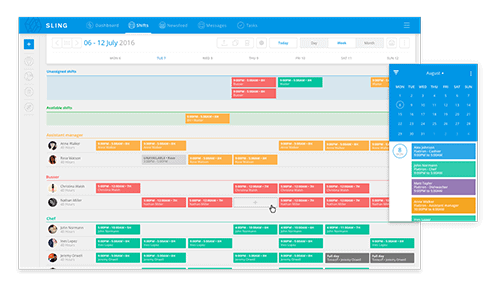
Workforce optimization allows you to make accurate predictions based on past models about precisely how many team members you’ll need to cover all your customers or the jobs at hand.
Advanced planning of this nature gives you incredible power over your weekly schedule template. You don’t have to find extra employees to work because you know exactly how many staff members you need to build an effective shift.
For example, by analyzing the data you gather through workforce optimization, you can see that your sales are increasing 10 percent over the same time last year.
Taking this data into account, you can plan for a 10-percent increase in the number of customers over the next scheduling cycle and the corresponding number of team members to handle the busy times.
Instead of starting at the beginning of your week and working to the end, build your schedule around the employees best suited for a particular shift.
This ensures that the employees most suited to each shift are working at that time. The lunch shift, for example, is an ideal time for you to schedule the most efficient employees.
The dinner shift, on the other hand, is perfect for the more personable employees who are willing to stop and chat for a while.

Creating a weekly schedule template is only part of the battle. To make things more complete for you and your employees, include an availability chart at the end of your form. When you go to fill out the schedule, you can refer to the availability chart to see who can work and who can’t.
A chart of this type — included with the final schedule — also helps your employees find their own substitutes so you don’t have to do all the work yourself.
In some cases, you only need to create the availability chart once. In other cases, you’ll need to create the chart every time you schedule your employees.
Software like Sling makes this process easy by keeping track of who works when, who has time off, and who is available to fill in as a substitute.
The best managers always have a backup for their backup — a plan C for their plan B, if you will. It’s inevitable that someone will get sick and the person who could have filled in for them has a family emergency to attend to. That’s the nature of business these days.
You can prepare for any eventuality by setting up a list of trusted and reliable part-time workers who are willing to work at a moment’s notice.
Options for this type of list include former employees who left on good terms and prospective employees who interviewed but didn’t get hired. It may be difficult to ask them to fill in, but you never know until you try.

There are few things worse than working the closing shift one day and the opening shift the very next day. Working late one evening and early the next morning can cut an employee’s downtime to just a few hours and take a real toll on their work/life balance.
Use your weekly schedule template to ensure that you give your team members at least 12 hours of time off between shifts.
When using any template to schedule your employees, make sure that you monitor each employee’s total hours worked and any overtime they accrue.
Keeping both of these numbers in mind when scheduling your team can help you control labor costs and keep overtime from running rampant over your bottom line.
Your weekly, monthly, and yearly payroll will also be easier and more straightforward if you monitor total hours worked and keep overtime to a minimum.
Organizational strategy — composed of three different levels: functional, business, and corporate — gives your business direction and provides goals for each employee to strive toward.
If you don’t have some semblance of an organizational strategy, your business is flailing at the starting line. Even something as simple as a vision or mission statement can help you make decisions that benefit your business.
One of those decisions is who to schedule when. With even the most basic strategy in place, you’ll discover new ways to schedule your employees in order to make your short-term, medium-term, and long-term goals a reality.
Don’t just blindly assign your employees to random shifts based on your feelings at the time. That’s a recipe for disaster.
Instead, implement a strategy for your business and then use it to make the best schedule possible for your team members, your customers, and your business.

The format you choose for your weekly schedule template plays a big role in the effectiveness of the final product.
For example, your employees might be used to reading a Gantt chart to find what task to work on next, but it’s highly unlikely that it would be as simple to find their next shift. Why? Because they’re not accustomed to using a Gantt chart in that way.
Team members would first have to learn how to read the chart. Then, they could move on to finding when they work next.
Using an unfamiliar format for any of your templates — and the final schedules on which they’re based — makes the process much more difficult for your employees.
To make the communication as familiar as possible (and, therefore, as clear as possible) use a familiar format for your weekly schedule template.
One of the best formats for this task (i.e., communicating dates and times) is the calendar. Most people have been reading calendars all their lives and are extremely adept at extracting information from that format.
With a calendar, they won’t have to learn how to decipher the format first. As a result, finding the information they’re looking for will be easier, and they’ll be less likely to make mistakes (i.e., misinterpret the dates and times).
That’s not to say that your weekly schedule template and the final rota you distribute have to look exactly like a calendar, but arranging it as a table with rows and columns is a good place to start.
If there’s one thing you can do to make the transition from weekly schedule template to final timetable easier, it’s to color-code information as much as possible.
If, when you fill in the weekly schedule template, it looks like a page from your accounting records, the final schedule is going to be a challenge to decipher.
Instead of getting rid of important information, reduce the amount of text on your template by color-coding one or two major variables.
For example, if you decide to print the shift as a range of numbers, the final schedule (pictured below) is going to feel cluttered, complicated, and overwhelming.
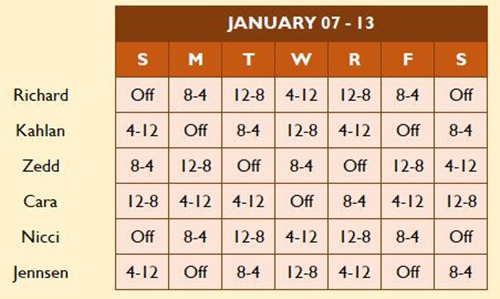
But, when you switch the time-worked variable from numbers and letters to colors, the final product is much easier to read.
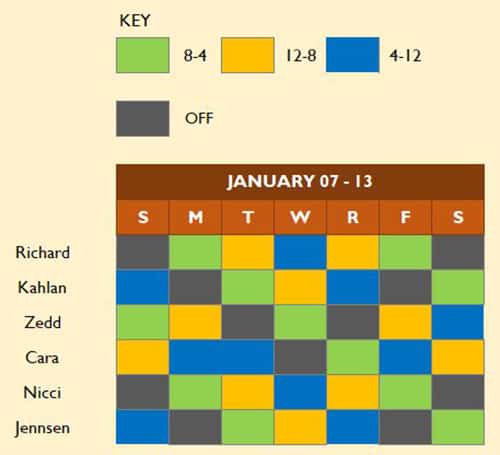
With color-coding, you can pack a lot of information into a small space and communicate it quickly to your employees.
Another option is to assign each team member their own color. You can then format the template to include more blocks (i.e., 8-4, 12-8, 4-12, and Off) and fill in the employee colors accordingly.
The final schedule would look similar to the one above, but the colors would represent individual team members instead of hour ranges.
Whether your document is paper or digital, creating and storing a blank copy of the weekly schedule template will save you a lot of time in the long run.
If you use an old copy of the schedule — with names, dates, and times already present — as the template for the next week of work, you’ll likely have to delete or rearrange a lot of the information before you get to the actual scheduling process.
Sure, some of the information may stay the same, but it’s highly unlikely that you’ll repeat the exact schedule from one week to the next.
Instead of wasting valuable time deleting and rearranging information, bring up a blank copy of the weekly schedule template and a copy of an old schedule you want to use as a reference.
Then, copy and paste from the old schedule to the template and fill in new information as necessary. Some scheduling programs even assist with this part of the job by incorporating autocomplete into the process.
After clicking on a certain shift, you can start typing an employee’s name and the program will bring up the names that match so you don’t have to scroll through a long list of team members to find the right one.
Advanced scheduling programs make assigning shifts even easier by offering drag-and-drop interaction within the template itself.
With that feature, all you have to do is drag an employee’s name from a list at the side to any open shift and the program does the rest.

Once you’ve got everything formatted the way you want it and a blank copy saved for later, you’re ready to put the document to use.
Here are some tips for getting the most out of your weekly schedule template.
Allowing your team to self-schedule serves two very important purposes:
Giving your employees this much freedom, though, can be nerve-wracking because you never know what the final shift will look like.
Instead of simply letting your team go wild with the schedule right off the bat, start by scheduling one or two of your best employees for each shift, and then give your team access to the weekly schedule template so they can fill in the empty slots.
After a few days, review the schedule, make any necessary changes, and send it out.
Give yourself enough lead time so that, once the weekly schedule template is complete, you can distribute the final schedule well in advance of when it goes into effect.
Doing so gives everyone involved time to:
If your schedule starts on Monday, and you distribute the schedule on Friday, your employees won’t have time to rearrange things so that their work and personal lives don’t clash.
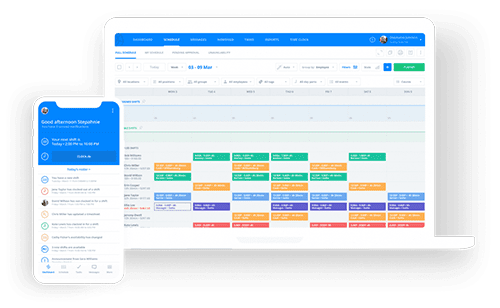
While you can certainly still use pencil and paper to create your weekly schedule template, it’s no longer the best tool for the job.
Modern scheduling and workforce management programs allow you to create, fill in, and distribute both the template and the final schedule in a fraction of the time it takes with any other available method.
Take advantage of what 21st-century technology has to offer and make use of the tools that will make your scheduling more effective and productive.
Conflicts arise because employees don’t have access to the schedule when they’re making plans outside of work.
With modern workforce management software, however, you can store frequently-used team documents — like the work schedule — in the cloud where everyone can access them anywhere, anytime.

The 21st-century technology we mentioned in a previous section also brings with it modern automation protocols.
For example, with a single tap or click, you can instruct the software to find and schedule an employee for a specific shift on a specific day based on variables such as:
The system then sorts through the relevant information, finds an employee, and inserts them into the schedule.
In some cases, you can incorporate such data as absenteeism rates and even past weather details to inform your decisions and make the final schedule the best it can be.
Making your employees responsible for finding a substitute to cover a shift they can’t work is a great way to distribute certain functions of the scheduling process to others in order to help everyone understand what goes into creating a staff rota.
So, instead of an employee calling you (or texting or emailing) to say they can’t come in, make it mandatory that they first inform the team that their shift is up for grabs and then follow through with lining up someone to take their place.
To further reduce the stress of your work life, we’ve included a simple weekly schedule template here. Download it, and make it yours.
Just click the image below for the excel version, or you can choose our Google Sheets version and make your own copy. (Don’t worry; there are detailed instructions in the download to help you out.)
Once you have your schedule template, you may also need help with:
Try the Sling app. It’s a work scheduler designed with the busy manager in mind. At its core, Sling addresses all the scheduling issues that a manager might face when scheduling employees.
The intuitive and well-organized scheduling tools Sling offers make it easy to create clear, easy-to-read schedules well in advance. The cloud-based platform solves the distribution problem by providing simple and convenient storage and distribution.
If that isn’t enough, you can even control who can view the schedule and who can make changes to it. All you have to do is give individuals permission or send them a link. They can log in to Sling to view the schedule anytime, anywhere.
Happy scheduling!
See Here For Last Updated Dates: Link
This content is for informational purposes and is not intended as legal, tax, HR, or any other professional advice. Please contact an attorney or other professional for specific advice.
Schedule faster, communicate better, get things done.